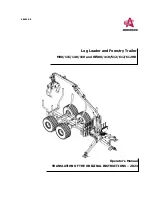
•
Before operating the traction unit with an
attachment, ensure that the attachment is properly
installed.
•
Do not place your feet under the platform.
Slope Operation
Slopes are a major factor related to loss-of-control and
tip-over accidents, which can result in severe injury or
death. All slopes require extra caution.
•
Do not operate the traction unit on hillsides or
slopes exceeding the angles recommended in the
Stability Data section in Stability Data (page 7), and
those in the attachment
Operator’s Manual
. See also
the Slope Indicator (page 8).
•
Operate up and down slopes with the heavy end
of the traction unit uphill.
Weight distribution
changes. An empty bucket will make the rear of
the traction unit the heavy end, and a full bucket
will make the front of the traction unit the heavy
end. Most other attachments will make the front of
traction unit the heavy end.
•
Raising the loader arms on a slope will affect the
stability of the machine. Whenever possible, keep the
loader arms in the lowered position when on slopes.
•
Removing an attachment on a slope will make the
rear of the traction unit heavy. Refer to the Stability
Data section in Stability Data (page 7), to determine
whether the attachment can be safely removed on
the slope.
•
Remove obstacles such as rocks, tree limbs, etc. from
the work area. Watch for holes, ruts, or bumps, as
uneven terrain could overturn the traction unit. Tall
grass can hide obstacles.
•
Use only Toro-approved attachments. Attachments
can change the stability and the operating
characteristics of the traction unit. Warranty may be
voided if used with unapproved attachments.
•
Keep all movements on slopes slow and gradual. Do
not make sudden changes in speed or direction.
•
Avoid starting or stopping on a slope. If the traction
unit loses traction, proceed slowly, straight down the
slope.
•
Avoid turning on slopes. If you must turn, turn
slowly and keep the heavy end of the traction unit
uphill.
•
Do not operate near drop-offs, ditches, or
embankments. The traction unit could suddenly turn
over if a wheel goes over the edge of a cliff or ditch,
or if an edge caves in.
•
Do not operate on wet grass. Reduced traction could
cause sliding.
•
Do not park the traction unit on a hillside or slope
without lowering the attachment to the ground and
chocking the wheels.
•
Do not try to stabilize the traction unit by putting
your foot on the ground.
Maintenance and Storage
•
Disengage the auxiliary hydraulics, lower the
attachment, set the parking brake, stop the engine,
and remove the key. Wait for all movement to stop
before adjusting, cleaning, or repairing.
•
Clean debris from attachments, drives, mufflers, and
engine to help prevent fires. Clean up oil or fuel
spillage.
•
Let the engine cool before storing and do not store
near flame.
•
Do not store fuel near flames or drain indoors.
•
Park the machine on level ground. Never allow
untrained personnel to service the machine.
•
Use jack stands to support components when
required.
•
Carefully release pressure from components with
stored energy.
•
Disconnect the battery before making any repairs.
Disconnect the negative terminal first and the
positive last. Reconnect positive first and negative
last.
•
Keep hands and feet away from moving parts. If
possible, do not make adjustments with the engine
running.
•
Charge batteries in an open well ventilated area, away
from spark and flames. Unplug the charger before
connecting or disconnecting it from the battery.
Wear protective clothing and use insulated tools.
•
Keep all parts in good working condition and all
hardware tightened. Replace all worn or damaged
decals.
•
If any maintenance or repair requires the loader arms
to be in the raised position, secure the arms in the
raised position with the hydraulic cylinder locks.
•
Keep nuts and bolts tight. Keep equipment in good
condition.
•
Never tamper with safety devices.
•
Keep the traction unit free of grass, leaves, or other
debris buildup. Clean up oil or fuel spillage. Allow
the traction unit to cool before storing.
5
Summary of Contents for 22337CP
Page 39: ...Schematics Electrical Schematic Rev A 39...
Page 40: ...Hydraulic Schematic Rev A 40...
Page 41: ...Notes 41...
Page 42: ...Notes 42...
Page 43: ...Notes 43...


























